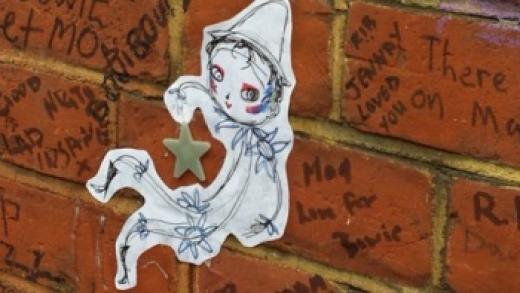PIERROT Pierrot - Wikipedia, the free encyclopedia https://en.wikipedia.org/wiki/Pierrot
In short, Pierrot became an alter-ego of the artist, specifically of the famously alienated artist of the nineteenth and early twentieth centuries.[3] His physical insularity; his poignant lapses into mutism, the legacy of the great mime Deburau; his white face and costume, suggesting not only innocence but the pallor of the dead; his often frustrated pursuit of Columbine, coupled with his never-to-be-vanquished unworldly naïveté—all conspired to lift him out of the circumscribed world of the Commedia dell'Arte and into the larger realm of myth. Much of that mythic quality ("I'm Pierrot," said David Bowie: "I'm Everyman")[4] still adheres to the "sad clown" of the postmodern era.
Google : 總之,皮埃羅成為藝術家的平素 錯錯,特別是十九世紀和二十世紀早期的著名藝術家疏遠的。[3]他的身體島國;他淒美的失誤成緘默症,偉大的啞劇Deburau的遺產;他蒼白的臉和服裝,這不僅清白,但死者的蒼白;他屢屢受挫的追求科倫拜恩的,再加上他從未要被征服不諳世事的天真,一切密謀抬他出來的即興喜劇的外接世界進入神話的大境界。多,神話質量(“我是皮埃羅,”大衛·鮑伊說:“我是普通人”)[4]仍然堅持後現代時代的“悲傷的小丑”。
Jean-Gaspard Deburau (born Jan Kašpar Dvořák;[1] July 31, 1796 – June 17, 1846), sometimes erroneously called Debureau, was a celebrated Bohemian-French mime. He performed from around 1819 to the year of his death at the Théâtre des Funambules, which was immortalized in Marcel Carné's poetic-realist film Children of Paradise (1945); Deburau appears in the film (under his stage-name, "Baptiste") as a major character. His most famous pantomimic creation was Pierrot—a character that served as the godfather of all the Pierrots of Romantic, Decadent, Symbolist, and early Modernist theater and art.
A specific fear of clowns has sometimes been discussed in terms of a specific phobia.[1] The term coulrophobia is a neologism coined in the context of informal "-phobia lists".
https://en.wikipedia.org/wiki/Coulrophobia
NPR
There are now, as far as we can tell, three distinct categories of clown quandaries:
1. People Actually Dressed As Clowns And Acting Creepy
2. Empty Clown-Related Threats Against Schools
3. Unfounded Hysteria
Coulrophobics Beware: America's Creepy Clown Problem Continues
People dressed as clowns are being arrested across the country, and face-painted Facebook threats are shutting down schools.
NPR.ORG
2016 "Creepy Clown" Epidemic[edit]
Main article: South Carolina clown sightings
In late summer and early fall of 2016, several cities in the United States began to experience 'clown sightings', where menacing-looking clowns would be seen, sometimes at the edge of forests.[19] Sightings occurred in several states. Ben Radford, author of Bad Clowns, says that clown sightings are more common during periods of social anxiety and can be related to the psychological effect of priming. In early October 2016 evil clown sightings occurred in Newcastle upon Tyne, England. A 13-year-old was cautioned by police after a17-year-old female was pursued down a street by him.[20]
On 4 October 2016 a youth was arrested in Blakelaw, UK in connection with reports of people allegedly dressing as clowns scaring passers-by.[21]
......何謂 ˊPierro,據葉靈鳳的解釋,說這個字含有先驅者的意思,戲劇開場前身著採衣插科打諢的報幕人,也可以稱之為ˊPierrot',用文藝點的話來說,....... ˊPierrot'一出現,必有一個新的局面,新的時代隨之而來,.......從象徵到現代 《戴望舒卷》 鴻範,1977
****
https://www.youtube.com/watch?v=xKyyTq_654M&t=11shttps://www.youtube.com/watch?v=xKyyTq_654M&t=11s
***
Pierrot, a character in pantomime, thievish, greedy, artless, and amoral; dressed in loose white garments, with his face whitened.
~ The Concise Oxford Dictionary of FRENCH LITERATURE.
***
David Bowie – Tears For A Clown

“I’m Pierrot, I’m Everyman. What I’m doing is Theatre and only Theatre...What you see on stage isn’t sinister, it’s pure clown. I’m using my face as a canvas and trying to paint the truth of our time on it. The white face, the baggy pants – they’re Pierrot, the eternal clown putting over the great sadness…” – David Bowie (1976)
“I'm Pierrot," said David Bowie: "I'm Everyman" Harry is dressed as Pierrot, a role that belonged to the italian comedy known as the “sad clown" of the ...
In 1976, he said in an interview: "I'm Pierrot. I'm Everyman. What I'm doing is theatre, and only theatre …
In short, Pierrot became an alter-ego of the artist, specifically of the famously alienated artist of the nineteenth and early twentieth centuries.[3] His physical insularity; his poignant lapses into mutism, the legacy of the great mime Deburau; his white face and costume, suggesting not only innocence but the pallor of the dead; his often frustrated pursuit of Columbine, coupled with his never-to-be-vanquished unworldly naïveté—all conspired to lift him out of the circumscribed world of the Commedia dell'Arte and into the larger realm of myth. Much of that mythic quality ("I'm Pierrot," said David Bowie: "I'm Everyman")[4] still adheres to the "sad clown" of the postmodern era.
Google : 總之,皮埃羅成為藝術家的
In short, Pierrot became an alter-ego of the artist, specifically of the famously alienated artist of the nineteenth and early twentieth centuries.[3]
Much of that mythic quality ("I'm Pierrot," said David Bowie: "I'm Everyman")[4] still adheres to the "sad clown" of the postmodern era.

沒有留言:
張貼留言